
Nequinate
CAS No. 13997-19-8
Nequinate( —— )
Catalog No. M21639 CAS No. 13997-19-8
Nequinate is an anticoccidial agent preventing coccidiosis .
Purity : >98% (HPLC)
 COA
COA
 Datasheet
Datasheet
 HNMR
HNMR
 HPLC
HPLC
 MSDS
MSDS
 Handing Instructions
Handing Instructions
| Size | Price / USD | Stock | Quantity |
| 5MG | 35 | Get Quote |


|
| 10MG | 53 | Get Quote |


|
| 25MG | 87 | Get Quote |


|
| 50MG | 140 | Get Quote |


|
| 100MG | 222 | Get Quote |


|
| 200MG | 331 | Get Quote |


|
| 500MG | 536 | Get Quote |


|
| 1G | Get Quote | Get Quote |


|
Biological Information
-
Product NameNequinate
-
NoteResearch use only, not for human use.
-
Brief DescriptionNequinate is an anticoccidial agent preventing coccidiosis .
-
DescriptionNequinate is an anticoccidial agent preventing coccidiosis .
-
In VitroXanthine oxidase (XOD) is a successful and safe drug target for lowering lower serum urate (sUA) levels , it plays an important role in the catabolism of purineNequinate shows an inhibition of 12.0% to inhibit XOD activities.
-
In Vivo——
-
Synonyms——
-
PathwayOthers
-
TargetOther Targets
-
RecptorOthers
-
Research Area——
-
Indication——
Chemical Information
-
CAS Number13997-19-8
-
Formula Weight365.43
-
Molecular FormulaC22H23NO4
-
Purity>98% (HPLC)
-
Solubility——
-
SMILESCCCCc1cc2c(cc1OCc1ccccc1)[nH]cc(C(=O)OC)c2=O
-
Chemical NameMethyl 6-butyl-4-oxo-7-phenylmethoxy-1H-quinoline-3-carboxylate
Shipping & Storage Information
-
Storage(-20℃)
-
ShippingWith Ice Pack
-
Stability≥ 2 years
Reference
1.Takayuki Nakajima Hiroshiet al. [Determination of nequinate and buquinolate in livestock products using liquid chromatography-tandem mass spectrometry].[J]. Shokuhinseigaku Zasshi Journal of the Food Hygienic Society of Japan 2011.
molnova catalog



related products
-
p-Coumaric Acid Ethy...
p-Coumaric Acid Ethyl Ester is the ethyl ester of p-Coumaric acid. p-Coumaric Acid is a potential immunosuppressive agent in treating autoimmune inflammatory diseases like rheumatoid arthritis.
-
Proteinase
Proteinases are enzymes that catalyse the breakdown of proteins. Proteinases are involved in many biological functions, including the digestion of ingested proteins, the breakdown of old proteins, and cell signalling.
-
PHM-27/PHI, human
PHM-27/PHI, human



 Cart
Cart
 sales@molnova.com
sales@molnova.com


